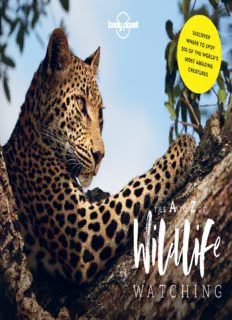
Lonely Planet’s A-Z of Wildlife Watching PDF
Preview Lonely Planet’s A-Z of Wildlife Watching
Introduction A smooth black fin emerges from the ocean, then another, and two more. Your pulse quickens. It’s a family of orcas, resident around the Bay of Islands in New Zealand, and they’re hunting rays on the sea floor, clearly visible in these transparent, shallow waters. The fact that this moment, an encounter with such graceful and powerful fellow inhabitants of our planet, was unexpected and unpredictable makes it all the more magical. Such is the joy of watching wildlife in its natural home. © Matt Munro | Lonely Planet For many people, one of the most rewarding experiences of travel is seeing creatures that you wouldn’t encounter back home. Whether you set out to see them deliberately on a safari or spot them through sheer luck, the thrill of them deliberately on a safari or spot them through sheer luck, the thrill of watching a wild animal go about its daily business always makes your senses tingle. But, we asked ourselves, how would you know what you had spotted? And if you wanted to see a particular animal, how would you know where to start looking? That was the genesis of this pictorial guide to 300 animals. © Jonathan Gregson | Lonely Planet To compile this book we turned to the highly experienced biologist and writer Amy-Jane Beer, who created a wishlist of weird and wonderful creatures from around the world. Mark Carwardine, who travels the world photographing wildlife, contributed a foreword. We included all of the most iconic animals – lions, tigers, elephants and sharks – in the alphabetical order but we wanted to go further than those headline acts and showcase much more of the mind- blowing diversity of the natural world. The realisation that such extraordinary wonders have evolved on our planet – these are just 300 out of more than eight million species – is humbling and inevitably prompts questions about our role and place in the world: no matter your age, few things spark curiosity like another living thing. © Philip Lee Harvey | Lonely Planet Between these covers, you’ll find descriptions of where to see a multitude of mammals, from snow leopards and mountains goats at the very top of the world, to such resourceful residents of African deserts as antelopes and the fennec fox. In the air, we’ve got birds and bats, from the giant albatross to thumb-sized hog-nosed bats – and also the occasional gliding lizard, fish or mammal. Under the waves, we’ll show you giant clams, corals, whales and the wobbegong. And we could have created a whole book just about incredible insects to spot – from beautiful butterflies to the formidable Hercules beetle. Each entry also suggests some of the places where you will have the best chance of seeing the animal. We hope that this book will inspire you to seek out some of the wildlife you’ve always wanted to see and add many more creatures to the list. © Matt Munro | Lonely Planet Amy-Jane Beer Amy studied Biology at Royal Holloway, University of London, and earned an unglamorous PhD studying the nervous systems of sea urchins. Urchins are fascinating, but with all of nature’s myriad splendours out there she found it hard to focus on just one species and set about becoming a generalist, a seeker of wild wonders, and a writer of science and natural history for all ages. She was editor of Wildlife of Britain and Animals Animals Animals magazines and currently edits Wildlife World magazine for the People’s Trust for Endangered Species. She writes books, regular features for BBC Wildlife magazine and Country Diary columns for The Guardian, and is working on her first novel – nature-inspired of course. She helps judge the BTO Bird Photographer of the Year competition. Her favourite wild species? Usually the one she’s privileged enough to be looking at.
Description: